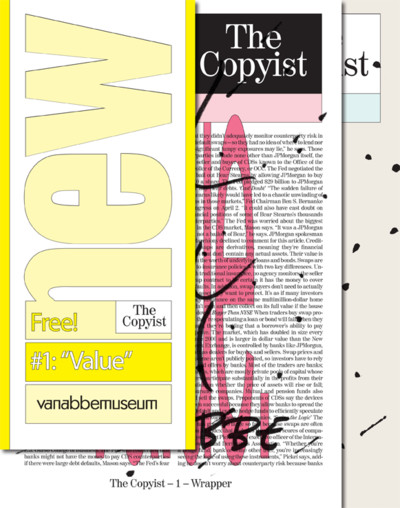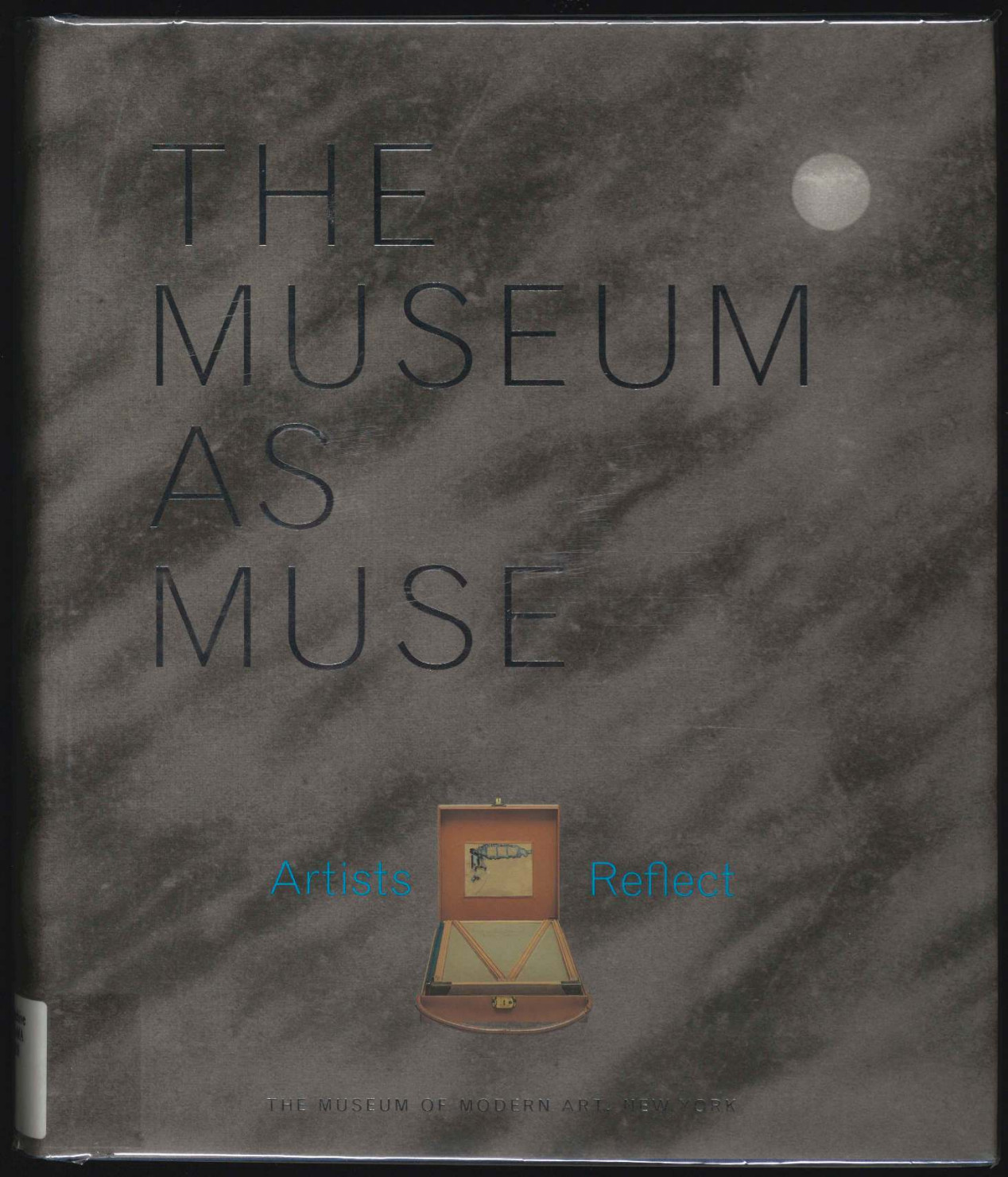The Copyist, 1: Value; The Exorcist, 2: Negotiation (2010-2011)
Filed under magazine | Tags: · art, collecting, museum

“In its 18-month Play Van Abbe programme, the Van Abbemuseum embarked on an exploration into what the museum of the 21st century might be. During this time, the Van Abbemuseum aimed to destabilise the idea of a ‘permanent collection’, activating its dynamism via a series of interruptions, outside interpretations and inside re-presentations.
The Copyist – a title referring to both the act of transcribing certain events in real time but also the duplication of already published material – mimics the outside/inside tension of the Play programme. Using a dual structure of core and wrapper, the journal invited curators, artists, activists, researchers and writers to contribute a constellation of ideas at the core of Play Van Abbe.”
“The Exorcist zooms in on the issue of ‘negotiation’. Today we seem caught in more, geographically and technologically complex forms of negotiation. Next to this there seems an almost unprecedented faith in the virtue of inclusion and communication. The magazine opens with texts reflecting on the ‘failed’ experiment ‘Backbench’, part of the last edition of Manifesta. Furthermore texts of and interviews with Dorothea Seebode (Philips Research), Markus Miessen, Simon Marschall and Chora Architects, offer a rich panorama of thoughts that deal with issues from production to politics and technology, to the use of maps in process of negotiation.”
Edited by Diana Franssen (1), Annie Fletcher, Metahaven, Clare Butcher, Steven ten Thije, and Christiane Berndes
Publisher Van Abbemuseum, Eindhoven, 2010-2011
ISSN 2210-2604 (1), 2211-7679 (2)
47 pages each
Publisher (no. 1)
Publisher (no. 2)
The Copyist, 1: Value (7 MB)
The Exorcist, 2: Negotiation (4 MB)
Museum Highlights: The Writings of Andrea Fraser (2005)
Filed under book | Tags: · aesthetics, appropriation, art, art criticism, autonomy, capital, collecting, conceptual art, curating, institutional critique, museum, performance, performance art

“Andrea Fraser’s work, writes Pierre Bourdieu in his foreword to Museum Highlights, is able to ‘trigger a social mechanism, a sort of machine infernale whose operation causes the hidden truth of social reality to reveal itself.’ It often does this by incorporating and inhabiting the social role it sets out to critique—as in a performance piece in which she leads a tour as a museum docent and describes the men’s room in the same elevated language that she uses to describe seventeenth-century Dutch paintings. Influenced by the interdisciplinarity of postmodernism, Fraser’s interventionist art draws on four primary artistic and intellectual frameworks—institutional critique, with its site-specific examination of cultural context; performance; feminism, with its investigation of identity formation; and Bourdieu’s reflexive sociology. Fraser’s writings form an integral part of her artistic practice, and this collection of texts written between 1985 and 2003—including the performance script for the docent’s tour that gives the book its title—both documents and represents her work.
The writings in Museum Highlights are arranged to reflect different aspects of Fraser’s artistic practice. They include essays that trace the development of critical ‘artistic practice’ as cultural resistance; performance scripts that explore art institutions and the public sphere; and texts that explore the ambivalent relationship of art to the economic and political interests of its time. The final piece, ‘Isn’t This a Wonderful Place? (A Tour of a Tour of the Guggenheim Bilbao),’ reflects on the role of museums in an era of globalization. Among the book’s 30 illustrations are stills from performance pieces, some never before published.”
Edited by Alexander Alberro
Publisher MIT Press, 2005
ISBN 0262062445, 9780262062442
xxxvii+291 pages
Reviews: Kirsi Peltomaki (Afterimage, 2005), Melissa Gronlund (Frieze, 2005), Louis Byrne (Art Book, 2007), N.A. Hayes (PopMatters, 2008).
PDF (104 MB, no OCR)
Comment (0)Kynaston McShine: The Museum as Muse: Artists Reflect (1999)
Filed under book, catalogue | Tags: · art, collecting, museum

“The Museum as Muse: Artists Reflect surveys the ways in which artists, mostly of the 20th century, have addressed the museum, commented on its nature, confronted its concepts and functions, drawn from its methods, and examined its relationship to the art it contains. This lively, involving, and intellectually provocative presentation encompasses a tremendous variety of artworks, large and small, intimate and expansive, in mediums both familiar and surprising: paintings, sculptures, photographs, drawings, prints, videos, and installations. Fully illustrated with the works of an international cross section of more than 60 artists.
Published on the occasion of the MoMA exhibition, this book features an introductory essay by Kynaston McShine, curator of the exhibition. In the ensuing plate secton, short entries by several authors on the art and artists accompany 233 illustrations representing works of artists such as Henri Cartier-Bresson, Elliott Erwitt, Eve Arnold, Garry Winogrand, and Thomas Struth. Personal museums and cabinets of curiosities, large and in miniature, have been created by Carles Wilson Peale, Marcel Duchamp, Joseph Cornell, Claes Oldenburg, Fluxus, and Mark Dion; others have focused on images of the destruction or transformation of museums, such as the painter Hubert Robert (the first curator of the Louvre), Edward Ruscha, Komar and Melamid, and Christo.
This wealth of material is followed by an anthology of manifestos, statements, and meditations written by artists; biographies and exhibition stories of the artists; and a bibliography of general and monographic publications.” (book jacket, modified)
Publisher Museum of Modern Art, New York, 1999
ISBN 0870700928, 9780870700927
296 pages
via MoMA
Exh. reviews: Robert Smith (NY Times, 1999), Economist (1999), Thomas Crow (Artforum).
Comment (0)
